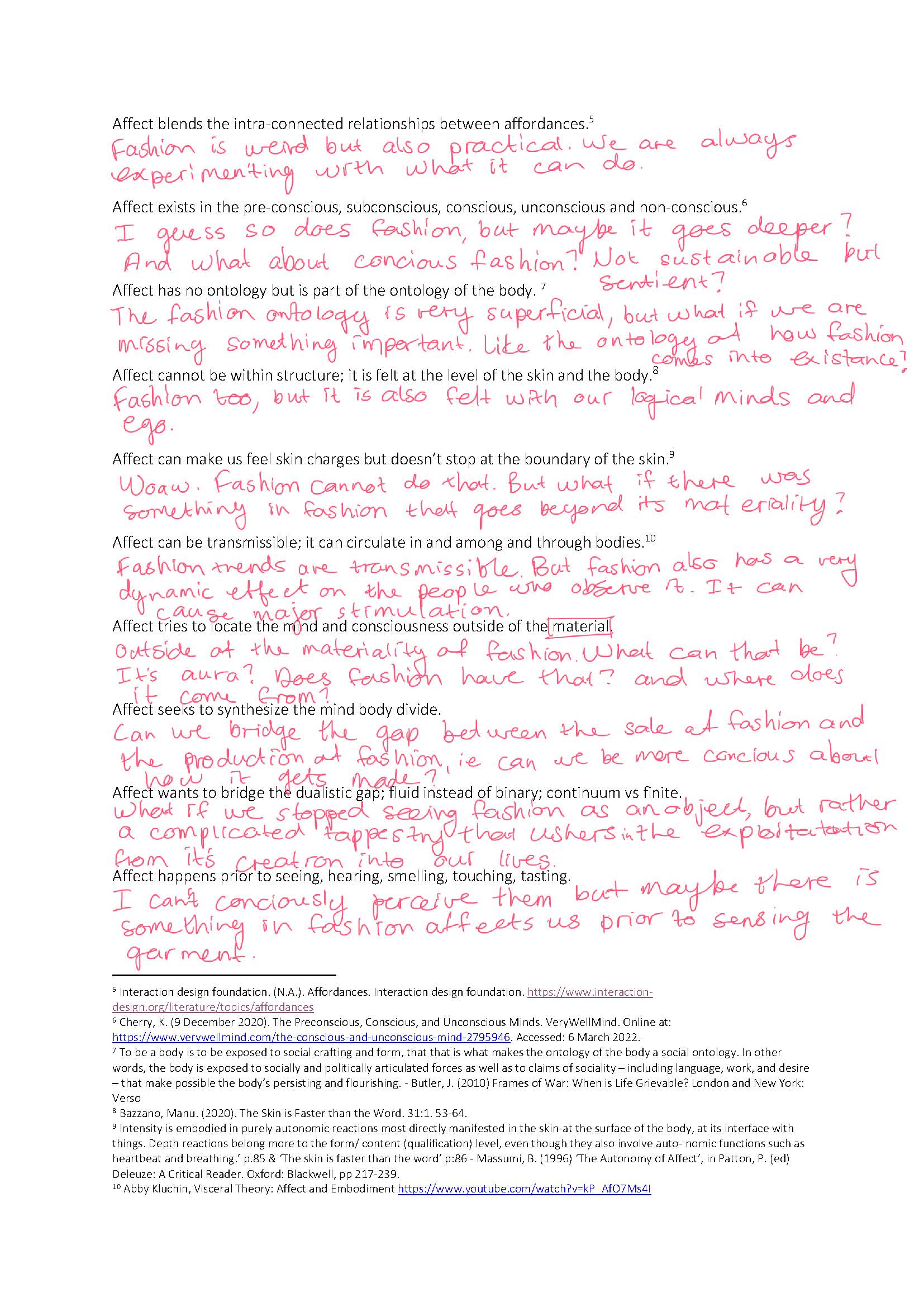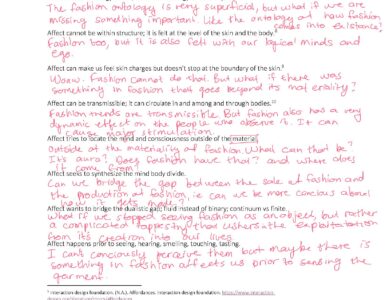(em)Body
My body is the only thing that genuinely has and always will be there. It has carried me through many of life’s adventures. It’s an expanding ‘satchel’ where I collect memories and store my lived experiences. It’s my safe space and shelter. All the adventures I have had up to now have shaped me into who I am today. My body is more valuable than any object I will ever own.
The concept of affect was tough to understand and required a lot of research. I came across many academic papers discussing the anthropological and evolutionary impact of material objects on humans, especially on our cognitive development. Still, I couldn’t find research that addressed the affective dimension of things. I wanted to use affect theory as the key proponent for supporting my hypothesis – ‘That Clothes Know Dark Secrets’– and that our wardrobes are imbued with a negative aura from the industrial fashion process. Furthermore, I wanted to specifically use affect to connect us to the disembodied fashion system – the bodies and entities that have been hidden from us.
To make my case, I preceded to do a thorough and broad reading on ‘affect theory’.
I started with Baruch Spinoza’s (1677)[1] ruminations on affect being a bodily experience. I made my way through illuminations by Giles Deleuze and Felix Guattari (1991)[2] , who more explicitly distinguished between affect and emotions. I also read various dense philosophical texts by Brain Masumi (1995-2015)[3]. He defines affect as “the capacity to affect and be affected”. The most enjoyable text was the neatly summarised ‘Affect Theory Reader’ by Gregory Seigworth and Melissa Gregg.[4]
Drawing inspiration from different authors helped me compose a poem on what affect could be. Understanding affect and how it connects us is the key, I feel, to understanding how potential and vitality are transmitted between garments and bodies. After each stanza, I inserted handwritten musings about how, in my opinion, affect relates to the fashion system.
[1] See Spinoza, B. (1996). Ethics. New York, NY: Penguin. (Original work published 1677)
[2] See Deleuze, G., Guattari, F. (1991). What is philosophy? (Tomlinson, H., Burchell, G. Trans.). New York, NY: Columbia University Press.
[3] See Massumi, B. (1995). The Autonomy of Affect. Cultural Critique, 31, 83–109. https://doi.org/10.2307/1354446
[4] See Gregg, M., & Seigworth, G. J. (Eds.). (2010). The affect theory reader. Duke University Press.
What is affect?
Annotated version
Affect cannot[1] be explained easily but can easily be encountered.
Fashion can be encountered everywhere and explained easily. Some parts of it, at least.
Affect (in philosophy) emphasizes the bodily or embodied experience.
Fashion emphasises the body and ideological experience.
Affect (in psychology) refers to the underlying intensities when processing an emotion or mood. [2]
Fashion directly and materially deals with our emotions and moods.
Affect allows us to understand spheres of experience and the wider set of relationships.
Fashion signals our experiences, affiliations and social relationships.
Affect can be broad: the point of intensity, the line of variation and the plane of potential.[3]
Fashion is also broad: washing lines, needlepoints, haute couture.
Affect cannot be represented or fully realised in language.
The word for writing and putting words together – text – is derived from textere: which means to weave. Text is also the root word for textile, a term that predates the usage of text.
Affect exists outside of the dominant paradigms of rhetoric and semiotics.[4]
Fashion and semiotics go together like white on rice! They both influence each other.
Affect deliberates beyond cartesian segregation.
Fashion loves to group and segregate.
Affect can be both positive and negative stimulation.
Same for fashion. In terms of value and senses.
Affect lies in the latent potentiality to engage vitality.
Oh, can fashion do that? What vitality lies in fashion? Perhaps the essence of the labourer who made the garment?
Affect blends the intra-connected relationships between affordances.[5]
Fashion is weird but also practical. We are always experimenting with what it can do.
Affect exists in the pre-conscious, subconscious, conscious, unconscious and non-conscious.[6]
I guess so does fashion, but maybe it goes deeper? And what about conscious fashion? Not sustainable but sentient.
Affect has no ontology but is part of the ontology of the body.[7]
The fashion ontology is very superficial, but what if we are missing something important? Like the ontology of how fashion comes into existence?
Affect cannot be within structure; it is felt at the level of the skin and the body.[8]
Fashion too, but it is also felt with our logical minds and egos.
Affect can make us feel skin charges but doesn’t stop at the boundary of the skin.[9]
Wow! Fashion cannot do that. But what if there was something in fashion that goes beyond its materiality? Affect in fashion!
Affect can be transmissible; it can circulate in and among and through bodies.[10]
Fashion trends are transmissible. But fashion also has a very dynamic effect on the people who observe it. It can cause significant sensorial stimulation.
Affect tries to locate the mind and consciousness outside of the material.
Outside of the materiality of fashion. What can that be? Fashion’s vitality? Does fashion have that? And where does it come from [insert sinister manufacturing process]?
Affect seeks to synthesise the mind-body divide.
Can we bridge the gap between the sale of fashion and the production of fashion? I.e. can we be more conscious about how it is made?
Affect wants to bridge the dualistic gap; fluid instead of binary; continuum vs finite.
What if we stopped seeing fashion as objects but rather a complicated tapestry of affects and events that ushers negativity into our lives.
Affect happens prior to seeing, hearing, smelling, touching, tasting.
I can’t consciously perceive it, but maybe there is something in fashion that affects us prior to sensing the garment on our skin?
Affect subsists of matter in flux, matter always moving.
Maybe there are more powerful forces in fashion beyond merely the threads it is spun from. Something that moves from creation to closet?
Affect encompasses the abstract and the material, the process, and the coding.
Gosh, this is blowing my mind. It opens up endless possibilities!
Affect presupposes a range of possibilities and possibilities presupposes a range of effects.
This one is even more profound. It’s like dropping a pebble in a pond. Where does it end?
Affect moves bodies, is in the movement of bodies and other bodies’ potential to move us.[11]
Fashion bodies, designer bodies, fashion microbiology, skin microbiology. What about the bodies we try to not think about, like the garment workers’?
Affect subverts the ramifications of ideological interpellation.[12]
So does this mean that everything I know about fashion is incorrect? Am I just believing some trite narrative that’s perpetuated by corporate greed?
[1] I switched from using is to can as can implies possibilities, whereas is stable, something frozen in time. Can is more related to affect. Minute 5:33 of this YouTube video -Aghast, A. (2019). Introduction to Affect Theory: Brian Massumi & Eve Sedgwick. (Youtube). Available at: https://www.youtube.com/watch?v=SeMS8QEYIQU
[2] Taken from the introduction paragraph on Wikiepedia – Affect (from Latin affectus or adfectus) is a concept, used in the philosophy of Baruch Spinoza and elaborated by Henri Bergson, Gilles Deleuze and Félix Guattari, that places emphasis on bodily or embodied experience. The word affect takes on a different meaning in psychology and other fields. https://en.wikipedia.org/wiki/Affect_(philosophy)
[3] Prof. Gregory Seigworth, a professor of communication studies in the department of communication and theatre at the Millersville university, explains his take on ‘Affect’ in an interview on ‘What is Affect Theory’ on the Let’s Talk about Art and Culture YouTube series. https://www.youtube.com/watch?v=PuKIqF72Bwo
[4] Patricia Ticineto Clough, Jean Halley (eds.), The Affective Turn: Theorizing the Social, Duke University Press, 2007, p. 1; Paul Hoggett, Simon Thompson (eds.), Politics and the Emotions: The Affective Turn in Contemporary Political Studies, Bloomsbury, 2012, p. 1.
[5] Interaction design foundation. (N.A.). Affordances. Interaction design foundation. https://www.interaction-design.org/literature/topics/affordances
[6] Cherry, K. (9 December 2020). The Preconscious, Conscious, and Unconscious Minds. VeryWellMind. Online at: https://www.verywellmind.com/the-conscious-and-unconscious-mind-2795946. Accessed: 6 March 2022.
[7] To be a body is to be exposed to social crafting and form, that is what makes the ontology of the body a social ontology. In other words, the body is exposed to socially and politically articulated forces as well as to claims of sociality – including language, work, and desire – that make possible the body’s persisting and flourishing. – Butler, J. (2010) Frames of War: When is Life Grievable? London and New York: Verso
[8] Bazzano, Manu. (2020). The Skin is Faster than the Word. 31:1. 53-64.
[9] Intensity is embodied in purely autonomic reactions most directly manifested in the skin-at the surface of the body, at its interface with things. Depth reactions belong more to the form/ content (qualification) level, even though they also involve auto- nomic functions such as heartbeat and breathing.’ p.85 & ‘The skin is faster than the word’ p:86 – Massumi, B. (1996) ‘The Autonomy of Affect’, in Patton, P. (ed) Deleuze: A Critical Reader. Oxford: Blackwell, pp 217-239.
[10] Abby Kluchin, Visceral Theory: Affect and Embodiment https://www.youtube.com/watch?v=kP_AfO7Ms4I
[11] Massumi, B. (2002). Parables for the virtual: movement, affect, sensation. Durham, NC, Duke University Press.
[12] I am referring here to Louis Althusser’s work and his ideas of subjugation because of the process of interpellation. Althusser, Louis. 1972. “Ideology and Ideological State Apparatuses” in Lenin and Philosophy and Other Essays. Monthly Review Press.



























